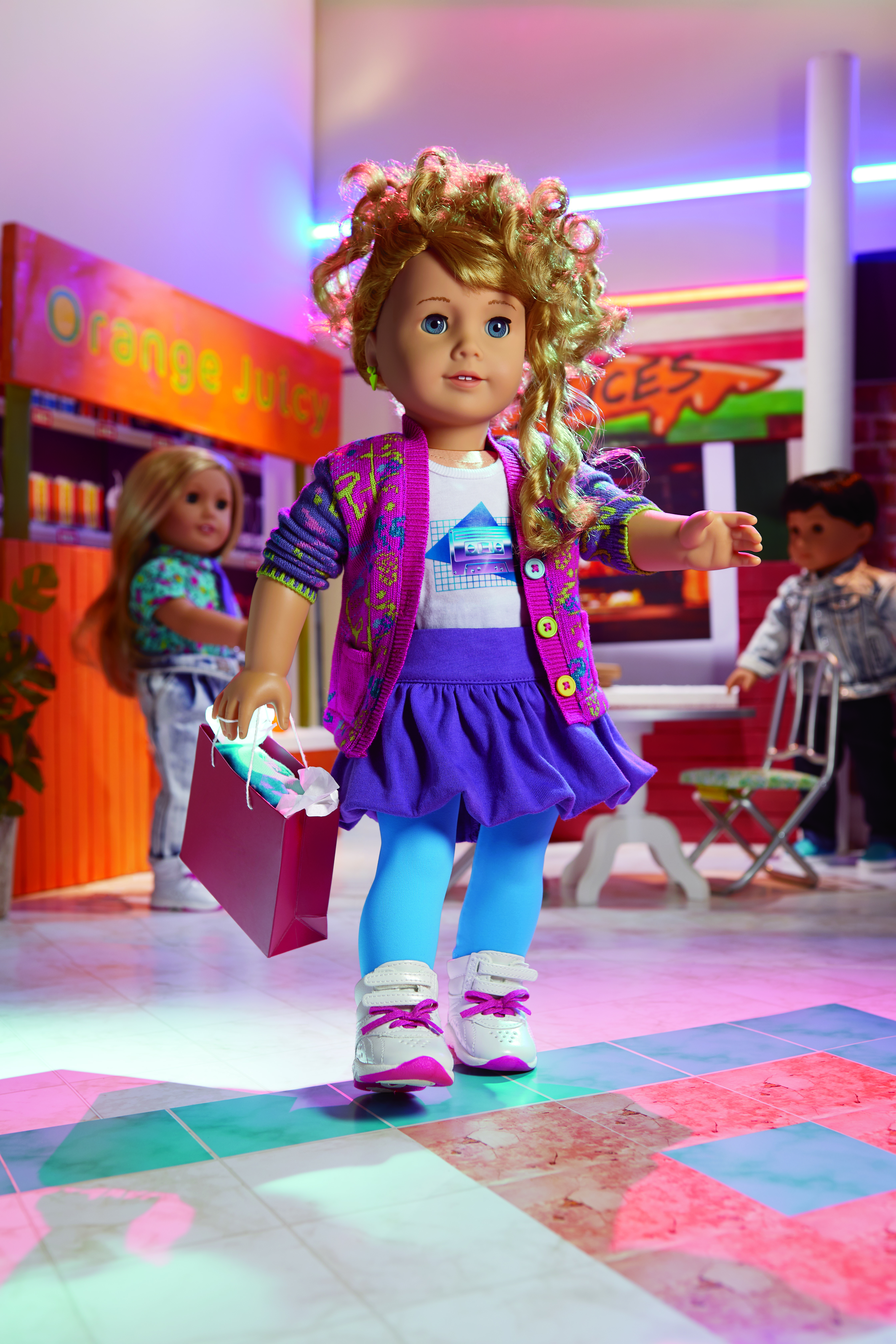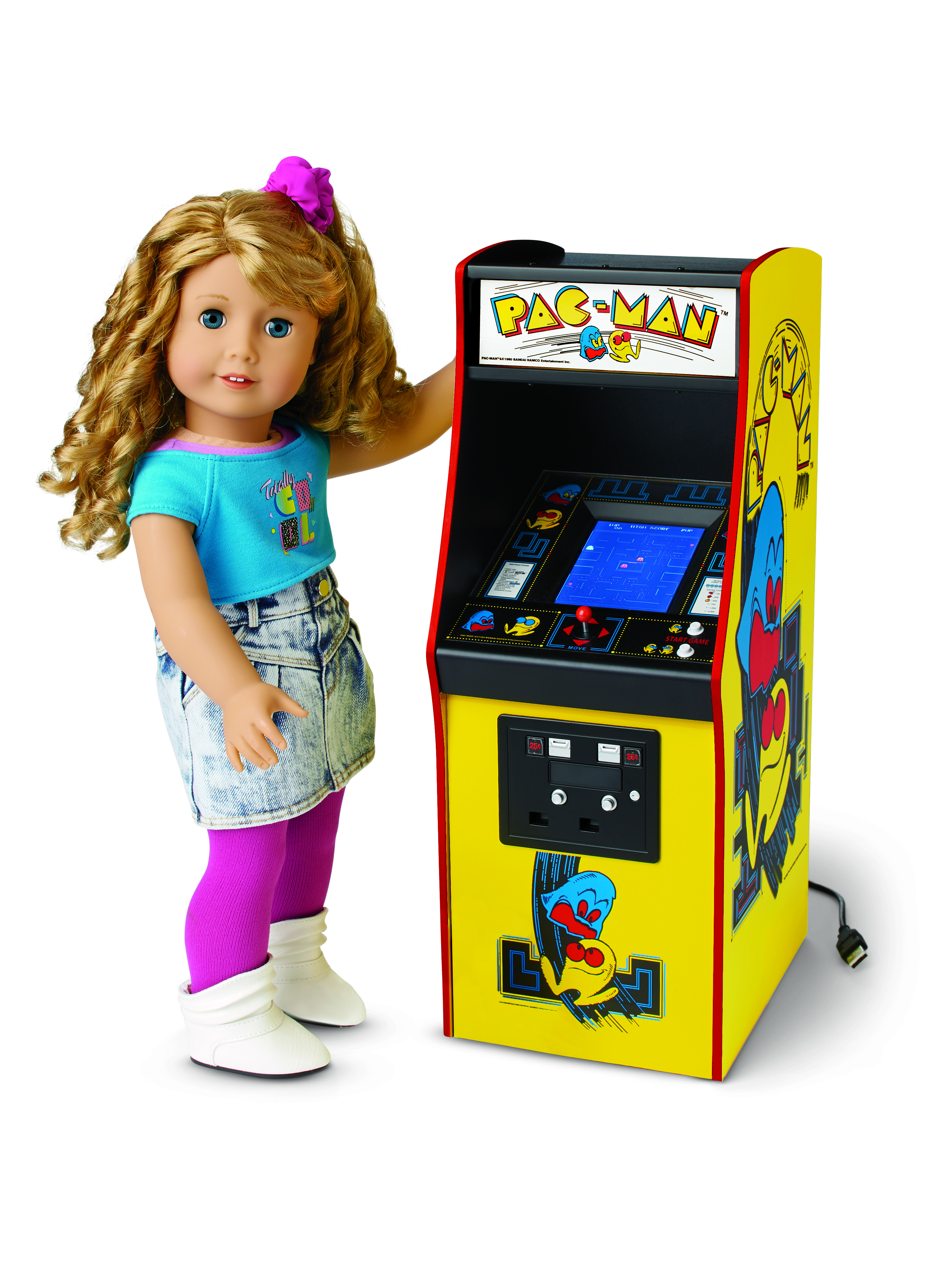When American Girl announced their newest Historical Character, a Pac-Man obsessed mallrat from 1986, a lot of people suddenly felt extremely old.
“When we were college students around 2004, 2006, we were doing ’80s parties for nostalgia, and now you see that with people a decade younger doing ’90s parties,” says Allison Horrocks, a historian who is also cohost of the American Girls Podcast, which covers the American Girl fandom. “It’s an interesting crisis it’s sending us into.”
Pop culture imaginings of history like those in the American Girl Historical Characters line do more than just make people squirm uncomfortably at their own childhoods becoming old enough to be history; they show the past through the funhouse mirror of the present. American Girl, launched with three doll characters in 1986, has long been at the forefront of transforming U.S. history into children’s historical fiction and toys. Every story about the past is a kind of intervention, and American Girl’s characters intervene just as books like Lies My Teacher Told Me intervene, even if they have different audiences and goals. Courtney is a doll, but she’s also part of the ongoing discussion of who video games are for and what they can or should be.

As with all of the Historical Character dolls, Courtney reflects a meticulous combination of research and storytelling. In the 1980s, video game consoles and VHS became commonplace while animated cartoons like Care Bears, He-Man and the Masters of the Universe, and My Little Pony combined sales and story to great commercial success. With her scrunchies, “pretend personal cassette player,” and Care Bears sleeping bag, Courtney reflects many aspects of 1980s media culture.
But the Pac-Man cabinet featured prominently on the cover of Courtney Changes the Game and available as one of the priciest pieces of Courtney’s extensive collection takes center stage—and prompted at least a dozen people to forward articles, product listings, and a celebratory music video my way. I wrote a whole book about coin-op video games and the way boyhood gets reimagined around them in the 1970s and 1980s, and I’ve written, too, about the distinct experience design that drives American Girl. Courtney’s story takes place in 1986, and the cabinet struck me, immediately, as weird.
Racquel Gonzales, Research Historian at the Strong Museum of Play in Rochester, New York points out some of that weirdness. “Pac-Man was arguably the first arcade game with mass popular culture resonance and ancillary products, but Courtney is somewhat nostalgic for a game that’s well beyond its “Pac-Man Fever” height,” Gonzales says. “While there’s no doubt an arcade might still have a hit like Pac-Man out on the floor, the fact that her local mall arcade is still open and thriving in 1986 makes it a standout among the thousands of U.S. arcades that closed their doors between 1982 and 1985.”

Indeed, while Pac-Man remains one of the highest grossing American arcade games in history, so does Ms. Pac-Man (1982), which circulated through 125,000 arcade cabinets and grossed $1.2 billion by 1987. While Pac-Man might have been in Courtney’s mall arcade, Ms. Pac-Man was just as or more likely to be there due to its more recent release. In the book Courtney Changes the Game, Courtney even mentions Ms. Pac-Man briefly when she starts imagining making a game of her own. But, Tessa Croker, the historian who leads research for American Girl Historical Characters, notes that the team was not able to license Ms. Pac-Man, which presented as a design constraint.
Additionally, I suspect Courtney’s story—of navigating challenges at home and school while dreaming up a video game heroine that would let her see herself on screen—wouldn’t work quite the same with the pink-bowed iconography of the later game front and center. Kellen Hertz, who has written multiple books for American Girl, including Courtney Changes the Game, notes a sense of adversity is really central to how characters move through the world: “American Girl stories are about girls who have agency — girls who engage with the world and take action to achieve what they want, even when they’re afraid and it’s hard and they aren’t sure if they’re going to succeed. American Girl characters are resilient and they’re resourceful.”
Every American Girl has her challenges, and Courtney, faced with a complex relationship with her stepsister, her mom’s campaign for mayor, and an intimidating school project, is no different. At American Girl, stories drive the development of the dolls, as does an effort to connect with contemporary girls.
“The actual development of our characters is a very iterative process. But it always starts with Story,” says Susan Jevens, who works in public relations at American Girl. “For our character-based lines, we always have a working list of story ideas, time periods, and issues and interests to consider. … We also conduct focus groups and research testing when developing a new character to ensure we are creating things that resonate with both girls and their parents. We balance this knowledge with past characters we’ve introduced, as well as with those things that might be trending at the moment.”
It makes sense that Courtney plays video games because most girls, today, play video games. Molly Jackson, a 6-year-old who has several American Girl dolls, told me she likes the Historical Characters because of their stories. Asked about Courtney, Jackson said, “I want the new one. I don’t really know anything about her except that she’s a gamer. My brother still thinks she’s dumb, but he likes her the most because she plays games.”
Charlotte Woods, age 6, loves playing video games like Animal Crossing and Mario Kart and says she likes dolls that like the kinds of things she likes. She’s excited about Courtney: “I know she likes video games. It’s cool and fun.”

That effort to connect not just with girls, but also with their parents means nostalgia is an important factor, too. Mary Mahoney, a historian who cohosts American Girls Podcast with Horrocks, says “There’s some expectation women this age would be buying these dolls for their daughter. There’s an opportunity for buying this and being like ‘Oh, I remember listening to cassettes,’ and your kid is like, ‘What’s that?’”
Karoline Beinek-Pentzer, age 8, an American Girl enthusiast has in her personal collection Julie, American Girl’s 1970s character who plays both basketball and pinball. Beinek-Pentzer plays Roblox, Sims, and other games, and she was excited to play Julie’s miniature pinball game in the American Girl store. However, she found Courtney’s Pac-Man cabinet less appealing: “There should be a couch and a TV and a lot of video games—little ones,” Beinek-Pentzer said.
Beinek-Pentzer is definitely onto something. As Gonzales points out, the real-life version of Courtney would likely have turned her attention to home gaming by 1986. Pac-Man was adapted for the Atari 2600 and ColecoVision within a few years of its release, and in 1985, the top-selling toy was a console: The Nintendo Entertainment System. In fact, Courtney’s friend Kip Tomatsu invites her over to play _Super Mario Bros_—a playdate she misses because she’s stuck posing for mayoral campaign portraits with her mom. But, Nintendo has long kept a notoriously tight control over its branding, so we’re not likely to see a doll-sized NES anytime soon.
There is some, at times, depressing realism in Courtney’s story: “As a kid I remember teachers and other parents and even peers being overtly sexist. So I wanted to capture that in the book,” says Hertz. “But I also wanted to show how Courtney’s mom and stepsister also deal with this sexism, and how they support each other through it, because I felt that growing up, too.”
But the arcade as imagined in the world of the book is a little less prone to hostile gender dynamics. For Courtney, video games are an obsession and an escape. The imagined arcade of her mall is somewhere she feels welcome, entering her initials over and over on the Pac-Man scoreboard and killing time between family obligations. While the Pac-Man cabinet offered for sale by American Girl has pretend coin slots, the book glosses over the cost of gameplay, although in its opening scenes, Courtney an hour into a game of Pac-Man, so the third grader could probably stretch a couple dollars into an afternoon of time at the cabinets. This is an impressive feat that might have aggravated an arcade owner; or, perhaps not—Pac-Man might have been sitting largely dusty in a corner by 1986.
Mahoney points to consumption as a defining aspect of the new doll: “This defines a generation by consumption. All I really know about her is what she’s like as a consumer. Is American Girl the brand like the 1980s identity through consumption?” Courtney’s world is as jampacked with pop culture references as American Psycho or Ready Player One, but this homage to 1980s pop culture carries a different type of story. Courtney’s love of video games and Cyndi Lauper songs and her effort to conceptualize her dream video game for a class project are all important, but so is her relationship with her stepsister, her mother’s campaign for mayor, and her friendships and rivalries with classmates. Hertz says, “Games are Courtney’s chance to be epic.” And, in games, Courtney is epic, but in her life, she has experiences many girls have to navigate. Maybe Pac-Man is a slightly anachronistic obsession for a girl in 1986, but the mall as youth hangout, and the enthusiasm for pop culture still resonate.
By the mid 1980s in the U.S., much of the industry had begun to focus overtly on boys and young men as consumers, leaning into gendered design and marketing strategies that largely ignored and were occasionally hostile to girls. 1986 is the year company founder Pleasant Rowland first launched American Girl, and Courtney has her own, miniature, American Girl doll, books, and even catalog. “They seem to be reinvesting in their own history and their own version of the 1980s,” Mahoney said. This is, perhaps, not the best time to lean into white nostalgia. American Girl, however, sees Courtney as “joining a recent wave of several diverse character dolls introduced from the brand over the past four years,” according to Jevens. The character development process is lengthy, and likely nobody working in any industry could have predicted a year like this one.
An additional reason Courtney’s story unfolds in 1986 despite being late for arcades is the Challenger launch and subsequent disaster. That unique historical moment plays a key role in the fictional book, but was also unusually visible to school children at the time because of the Teacher in Space program through which teacher Christa McAuliffe became part of the mission crew. According to Gonzales, more children than adults watched the Challenger launch.
Those unusual circumstances played a key role in the research for Courtney and her world. Says Croker, “It is not always easy to understand an event from a child’s point of view, but in the case of the Challenger we could access all kinds of sources and really get a sense of how viewing that event would impact a child.”

The mission had stirred national enthusiasm for the space program, and students had looked forward with enthusiasm to the launch, for which Croker says many schools acquired satellite connections and TVs to facilitate in-class viewing. That moment of collective shock and grief is pivotal to Courtney’s story, as her class decides to forge ahead with their Dream Big projects, and Courtney struggles to finish her game concept. At the eleventh hour, she decides to change the end of her game. Her heroine doesn’t have to destroy the bad guys just because that’s how games are. Instead, Courtney makes a game that requires collaboration to save the Earth, in a nod to 1980s environmentalism. She realizes she can tell a different kind of story. That idea of girls’ particular ability to drive change is reiterated over and over through the brand and its various initiatives (with the launch of Courtney, American Girl has also partnered to fundraise for Girls Who Code).
American Girl doesn’t tell history—of video games or anything else—in a way that exhibits complete fidelity. But, that isn’t really the point. “By putting girls at the center of historical fiction, we help to restore some balance in the historical narrative,” says Croker. “If girls can’t see themselves in history, how can they see themselves as changemakers in the future? American Girl tells girls that they matter, that their place in history matters and has always mattered.”
That effort to help people see themselves in the past is one I’m both sympathetic to and invested in. It’s why I wrote a book about Brenda Laurel, and it’s why I’m currently documenting the games for girls movement. The past often exists as a kind of highlight reel in popular imagination, so we remember Pac-Man but not necessarily the dozens of contemporary games with fair to middling sales; we know about Nolan Bushnell but not Lila Zinter. The highlight reel flattens the complexity out of the past, and it renders much invisible.
The historical intersections of girls and video games are fraught. Popular representations of the arcade and celebrations of gaming in magazines, on television, and in Hollywood films like Tron and WarGames, all celebrated the arcade as a place where boys could excel. Girls played games in the 1980s, but they were rarely the target market or the faces on screen. In reimagining the history of videogames through Courtney’s story, American Girl presents a compelling counternarrative: a world where gaming’s golden era belongs just as much to a Care Bear-obsessed girl as it does to anyone else.
from VICE US https://ift.tt/3nmP1AN
via cheap web hosting
No comments:
Post a Comment